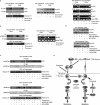Curcumin enhances the efficacy of chemotherapy by tailoring p65NFκB-p300 cross-talk in favor of p53-p300 in breast cancer
- PMID: 22013068
- PMCID: PMC3234918
- DOI: 10.1074/jbc.M111.262295
Curcumin enhances the efficacy of chemotherapy by tailoring p65NFκB-p300 cross-talk in favor of p53-p300 in breast cancer
Abstract
Breast cancer cells often develop multiple mechanisms of drug resistance during tumor progression, which is the major reason for the failure of breast cancer therapy. High constitutive activation of NFκB has been found in different cancers, creating an environment conducive for chemotherapeutic resistance. Here we report that doxorubicin-induced SMAR1-dependent transcriptional repression and SMAR1-independent degradation of IkBα resulted in nuclear translocation of p65NFκB and its association with p300 histone acetylase and subsequent transcription of Bcl-2 to impart protective response in drug-resistant cells. Consistently SMAR1-silenced drug-resistant cells exhibited IkBα-mediated inhibition of p65NFκB and induction of p53-dependent apoptosis. Interestingly, curcumin pretreatment of drug-resistant cells alleviated SMAR1-mediated p65NFκB activation and hence restored doxorubicin sensitivity. Under such anti-survival condition, induction of p53-p300 cross-talk enhanced the transcriptional activity of p53 and intrinsic death cascade. Importantly, promyelocyte leukemia-mediated SMAR1 sequestration that relieved the repression of apoptosis-inducing genes was indispensable for such chemo-sensitizing ability of curcumin. A simultaneous decrease in drug-induced systemic toxicity by curcumin might also have enhanced the efficacy of doxorubicin by improving the intrinsic defense machineries of the tumor-bearer. Overall, the findings of this preclinical study clearly demonstrate the effectiveness of curcumin to combat doxorubicin-resistance. We, therefore, suggest curcumin as a potent chemo-sensitizer to improve the therapeutic index of this widely used anti-cancer drug. Taken together, these results suggest that curcumin can be developed into an adjuvant chemotherapeutic drug.
Figures






Similar articles
-
Sulphur alters NFκB-p300 cross-talk in favour of p53-p300 to induce apoptosis in non-small cell lung carcinoma.Int J Oncol. 2015 Aug;47(2):573-82. doi: 10.3892/ijo.2015.3061. Epub 2015 Jun 22. Int J Oncol. 2015. PMID: 26095308
-
Chromatin remodelling protein SMAR1 inhibits p53 dependent transactivation by regulating acetyl transferase p300.Int J Biochem Cell Biol. 2012 Jan;44(1):46-52. doi: 10.1016/j.biocel.2011.10.020. Epub 2011 Nov 3. Int J Biochem Cell Biol. 2012. PMID: 22074660
-
Coordinated regulation of p53 apoptotic targets BAX and PUMA by SMAR1 through an identical MAR element.EMBO J. 2010 Feb 17;29(4):830-42. doi: 10.1038/emboj.2009.395. Epub 2010 Jan 14. EMBO J. 2010. PMID: 20075864 Free PMC article.
-
Meta analysis of bioactive compounds, miRNA, siRNA and cell death regulators as sensitizers to doxorubicin induced chemoresistance.Apoptosis. 2022 Oct;27(9-10):622-646. doi: 10.1007/s10495-022-01742-z. Epub 2022 Jun 18. Apoptosis. 2022. PMID: 35716277 Review.
-
Curcumin in the treatment of urological cancers: Therapeutic targets, challenges and prospects.Life Sci. 2022 Nov 15;309:120984. doi: 10.1016/j.lfs.2022.120984. Epub 2022 Sep 20. Life Sci. 2022. PMID: 36150461 Review.
Cited by
-
The effect of curcumin on breast cancer cells.J Breast Cancer. 2013 Jun;16(2):133-7. doi: 10.4048/jbc.2013.16.2.133. Epub 2013 Jun 28. J Breast Cancer. 2013. PMID: 23843843 Free PMC article.
-
Comparative Study of Different Nano-Formulations of Curcumin for Reversal of Doxorubicin Resistance in K562R Cells.Pharm Res. 2017 Feb;34(2):279-289. doi: 10.1007/s11095-016-2060-8. Epub 2016 Nov 4. Pharm Res. 2017. PMID: 27815791
-
Status and Challenges of Plant-Anticancer Compounds in Cancer Treatment.Pharmaceuticals (Basel). 2021 Feb 14;14(2):157. doi: 10.3390/ph14020157. Pharmaceuticals (Basel). 2021. PMID: 33673021 Free PMC article. Review.
-
Phosphorylation of IκBα at serine 32 by T-lymphokine-activated killer cell-originated protein kinase is essential for chemoresistance against doxorubicin in cervical cancer cells.J Biol Chem. 2013 Feb 1;288(5):3585-93. doi: 10.1074/jbc.M112.422170. Epub 2012 Dec 17. J Biol Chem. 2013. PMID: 23250755 Free PMC article.
-
Curcumin as an Enhancer of Therapeutic Efficiency of Chemotherapy Drugs in Breast Cancer.Int J Mol Sci. 2022 Feb 15;23(4):2144. doi: 10.3390/ijms23042144. Int J Mol Sci. 2022. PMID: 35216255 Free PMC article. Review.
References
Publication types
MeSH terms
Substances
LinkOut - more resources
Full Text Sources
Research Materials
Miscellaneous

